![]()
![]()
![]()
Use LEFT and RIGHT arrow keys to navigate between flashcards;
Use UP and DOWN arrow keys to flip the card;
H to show hint;
A reads text to speech;
106 Cards in this Set
- Front
- Back
|
The IP layers is a collection of
|
The IP layers is a collection of routers
|
|
|
What are the important fields in the IP datagram?
|

Source and Destination IP address
|
|
|
What is the high-level process to transport voice on the network
|

1) Codec scheme is used to digitize anlalog voice using sampling
2) IP will be used to packetize the digital signal, so that the data is converted into IP packets |
|
|
Does the IP network know anything about voice?
|
NO. The IP network simply sees packets. The routers do not see the payload inside the packets
|
|
|
Show analog vs Digital
|

|
|
|
Voice is similar to an application and IP runs at the network layer, what else is needed to move voice
|
Transport Layer. Transport layers run inbetween Application and Network layer
|
|
|
What are the Transport Layer protocols?
|
TCP, UDP, and SCTP
|
|
|
What type of communication is IP
|
IP – host to host communication
|
|
|
What does IP use for host to host communication?
|
Socket: IP + TCP/UDP Port number
Process to process communication |
|
|
The most important thing for Voice Over IP is
|
communication quality
|
|
|
What does communiction quality represent?
|
Whatever the caller says the listerner can hear and understand
|
|
|
What service that TCP has is important for Voice Over IP and used in UDP?
|
We need/like some of the services that TCP provides
Packets are delivered in sequence |
|
|
What services that TCP has that are problems for Voice Over IP?
|
Acknowledgement and Error control (retransmission)
would cause long delay Congestion and flow control long delay and jitter TCP segment overhead (20 bytes) can you turn these services off? |
|
|
Assuming G.729A how many bytes in the sample?
|
G.729A = 8000 bits sample per second
8000 (bits) /8 = 1000 (bytes) 1000/1000 = 1 ms = 1 byte 20ms * 1 = 20 bytes |
|
|
What is the overhead with TCP?
|
TCP segment overhead (20 bytes), which nearly the same as the thepayload, so it is nearly 100 percent
|
|
|
What is UDP primarily used for in Voice Over IP?
|
socket management. It's okay for the process to process communication. It's too simple to be used as the only protocol for Voice Over IP. There are many other services needed.
|
|
|
What are essentials features of voice communication?
Is packet loss acceptable? |
A little bit of loss is okay. However, 2-3% of loss will be an issue.
We need a way to track packet loss. |
|
|
What mechanism is used to track packet loss?
Does UDP use this mechanism? |
Sequence number are needed to track and caluclate packet loss.
UDP does not use sequencing |
|
|
What is the RFC # and date for RTP and RTCP?
|
Defined in RFC1889 – 1996
RFC1889 also defines the RTP Control Protocol (RTCP) |
|
|
How does RTP differ from UDP as it relates to packet loss?
|
RTP includes sequencing, a field for payload type, and time stamp
|
|
|
RTP provides information – services – to applications so that it can deal with VoIP-problems like
|
RTP provides information – services – to applications so that it can deal with VoIP-problems like reordering, delay, and jitter
|
|
|
Does RTP run on top of TCP or UDP?
|
UDP
|
|
|
What is the difference between RTP and RTCP?
|
RTP carries voice payload (“data”), RTCP carries control information (“signaling”)
|
|
|
Usually Transport applications use well known ports, such as
Telnet uses TCP port number What port addresses does FTP use? Are there well known ports for RTP? |
Telnet uses TCP port number is 23
FTP uses 21 and 22, 21 for control, 22 for data There are no well known ports for RTP and RTCP. They both rely on signaling protocols, such as H.323 or SIP to negotiate to determine the ports to be used in the communication |
|
|
What is the relationship between RTP and RTCP?
|
RTP and RTCP sessions are always opened in pairs
RTP – even port number RTCP – odd port number (RTP port + 1) |
|
|
Is there a predifned port number for RTP and RTCP?
|
No.
|
|
|
When someone references RTP port number, they really mean what?
|
UDP port numbers
|
|
|
What are the essential services provided by RTP?
|
On top of UDP (not a standard, but a practice)
It does not have a well-known port number. What is a well-known port number? Ans: 1-1023 No guarantee of packet delivery (Packet could e lost) A sequence number – can be used to guarantee that the packets are delivered in sequence Timestamp – can be used to synchronize the media payout RTP does not guarantee anything; it simply provides more information about the transmission. |
|
|
Payload type store what essential information?
|
Codec scheme
|
|
|
What are some essential data field in RTP?
|
Padding (P) – to maintain 32-bit boundaries
Extension (X) – if the X bit is set, the RPT header is followed by exactly one header extension (see Figure 2-13). Payload Type – 7-bit for payload ID; one PT per packet (except for possibly RED) Sequence Number – to maintain the packers are delivered in sequence and to check lost packets 16 bits >>> 65,536 packets MAX can be kept in sequence |
|
|
Why do we need sequence number?
|
We need to ensure the packets are delivered in order for voice and we need to know if packets are lost. If the packets are delivered out of order you there has been loss
|
|
|
How is timestamp used?
|
Timestamp
Can be used differently for different payload types Clock frequency is defined as part of profile info Synchronization Source (SSRC) – the RTP packet sender (usually) Important for voice conference situations 32 bits >>> 4+ billion unique Sources Contributing source (CSRC) Again, useful for conferences Up to 15 CSRCs allowed |
|
|
What is essential about the RTP payload?
|
Analog => digital => voice frame => packetized
Payload type (7-bit) Media type (codec scheme) -law, A-law, and many more Many vocoders >>> many payload types – identified in tables 2-1 and 2-2 Room for future flexibility – “dynamic” payload types 96 - 127 RTP sender does not know what the codec scheme that a receiver can handle. Therefore, the payload type is included in the RTP header. Signaling schemes can be applied to negotiate the codec scheme for the session depending upon what the endpoints |
|
|
Should the sender and receiver first agree on the payload type or should they choose any type the receiver supports?
Ispayload type really needed? |
No. Signaling protocols such as H.323 and SIP are much more recent than RTP.
It's very unlikely that during the communication that the type will change. However, there are circumstances where the payload type would be changed in the middle of a communication, which is to concerve bandwidth, such changing from g.711 to G.729. Technically its possible, practically probably not used this way |
|
|
What is the other important protocol that solves the problem of packet loss?
|
REDundant Payload Type (RED)
|
|
|
What RFC defines RED?
|
Defined in RFC2198
|
|
|
What is the problem that RED solves?
|
Packet loss.
|
|
|
What is the default solution for packet loss?
|
The receiver will play the packet of the previous packet to fill the void
|
|
|
How does RED handle packet loss?
|
There is no retransmission. Because retransmission will cause delay and is not an acceptable solution in Voice Over IP cvommunication.
The solution is redundandancy. Every sample will be sent twice. The previous packet is sent along with the current packet. |
|
|
Show diagram for how RED handles packet loss
|
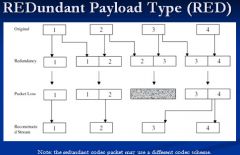
|
|
|
Does the process of sending redundant packets introduce delay?
|
No. But it requires additional bandiwdth. So instead of 8K it requires 16K. Instead of 20ms sample you will send 40ms worth of data
|
|
|
Sender and receiver must support RFC 2198 and both must agree on the procedure to use redundancy
|
RFC
|
|
|
What codec is supported by all voip devices?
|
G.711
|
|
|
RTP is for payload and RTCP is for
|
report
|
|
|
What are the RTCP message formats
|
RTCP Message Types (five of them)
Sender Report (SR) Receiver Report (RR) Source Description packet BYE APP: Application-defined packet |
|
|
If RTP and RTCP use the same frame format how do you distinguish between the two protocols?
|
Packet format similar to that of RTP
Different Payload Type (PT) values identify the different RTCP messages |
|
|
How do you distingusih between Sender report and receiver report?
|
Payload type
|
|
|
Exam: How is Round Trip Time calculated
|
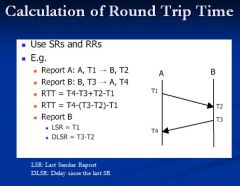
|
|
|
What is jitter?
|
What is jitter
Variation in delay Jitter = Mean deviation of the difference in packet reception Timing diagrams here Note the formula (p. 65) Calculated continuously, sent in each SR and RR |
|
|
How do caluclate jitter?
|

|
|
|
How often do we need to send RTCP packets.
|
There's no fixed answer, but certainly much less than five percent
|
|
|
What is the bandwidth does Voice Over IP consume? How is the overhead?
|
G.711 = 64K
1 sec = 64,000 bits 1 ms = 8000 bytes 10ms = 80 bytes G711 (10ms) |
|
|
Calculate the payload for RTP.
Calculate the total overhead of a RTP packet What is the true bandwidth? |
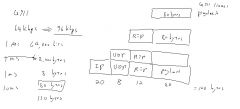
|
|
|
How many simultaneous calls can be made on a T1 with TDM and VoIP?
|

|
|
|
What is the ITU-T standard for numbering plan
|
E.164
E.164 is an ITU-T recommendation that defines the international public telecommunication numbering plan used in the PSTN and some other data networks. It also defines the format of telephone numbers. E.164 numbers can have a maximum of fifteen digits ITU-TSB: Telecommunication Standardization Board Tied to treaty obligations: specific roles and obligations defined for ITU Member States and TSB Director) Define number structure and functionality for four principal categories of numbers: Geographic Area Global Services Networks Groups of Countries (“GoCs”) |
|
|
What is the north american numbering plan called?
|
NANP
|
|
|
Show the North American Numbering Plan
|

Area Code, Exchange, and Station
|
|
|
What are some reserved Number Plan Area (NPA) codes
|
456 Carrier Specific Service
500 “follow me” personal communication service 800, 888, etc. Toll Free service 900 Premium Service (calling party pay) |
|
|
What the reserved N11 codes? Which mandated by the FCC?
|
211 What is it?
311 Non-Emergency Police and Fire 411 Local Directory Assistance 611 Repair Service* 911 Emergency Number 911 |
|
|
What is the
Numbering Plan Area (NPA) |
Numbering Plan Area (NPA)
Numbering Plan Areas (NPAs) have been created in accordance with principles that tend to maximize customer understanding, while minimizing both dialing effort and telephone plant cost. Boundaries are established to last for long periods of time, and their locations are based on estimates of future requirements at the time they are drawn. Reevaluation of boundaries sometimes suggests that better ones could have been selected. However, making changes after the passage of time would often cause massive customer disruption, numerous number changes, and expensive plant rearrangements. Principles considered in planning NPA boundary changes resulting from either the creation of new NPAs or the realignment of existing ones are as follows: Boundaries must not extend across state lines. Boundaries should coincide with other political subdivision boundaries where practical. When this is impractical, boundaries should follow recognizable physical geographic features or structures; i.e., rivers, large lakes, mountain ranges, and major highways. Boundaries should be drawn so as to minimize the splitting of communities of interest of recognized metropolitan areas, looking both at the present and the future. |
|
|
What is E.164?
|
NPA
|
|
|
International Numbering
|
If you have made international calls, you know that the familiar NANP is a subset of the ITU international plan.
Today, the trunk code, local code and subscriber number may be as many as 17 digits. So an international number can be as many as 20 digits. Some switching centers serve as International Gateway offices. |
|
|
Show the VoIP Service Architecture
|
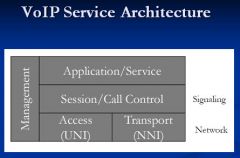
|
|

What type of VoIP solution use this type of architecture?
|
Skype
|
|
|
What is the difference between FXO and FXS?
What type of interface do FXO and FXS use? |
FXS and FXO are the name of ports used by Analog phone lines (also known as POTS - Plain Old Telephone Service) or phones.
FXS - Foreign eXchange Subscriber interface is the port that actually delivers the analog line to the subscriber. In other words it is the ‘plug on the wall’ that delivers a dialtone, battery current and ring voltage. FXO - Foreign eXchange Office interface is the port that receives the analog line. It is the plug on the phone or fax machine, or the plug(s) on your analog phone system. It delivers an on-hook/off-hook indication (loop closure). Since the FXO port is attached to a device, such as a fax or phone, the device is often called the ‘FXO device’. FXO and FXS are always paired, i.e similar to a male / female plug. RJ-11 |
|
|
Show FXO and FXS without a PBX
|

Without a PBX, a phone is connected directly to the FXS port provided by a telephone company.
|
|
|
Show FXS and FXO with a PBX
|

If you have a PBX, then you connect the lines provided by the telephone company to the PBX and then the phones to the PBX. Therefore, the PBX must have both FXO ports (to connect to the FXS ports provided by the telephone company) and FXS ports (to connect the phone or fax devices to).
|
|
|
What is a FXO Gateway
|
FXS & FXO & VOIP
You will come across the terms FXS and FXO when deciding to buy equipment that allows you to connect analog phones to a VOIP Phone System or traditional PBXs to a VOIP service provider or to each other via the Internet. An FXO gateway To connect analog phone lines to an IP phone system you need an FXO gateway. This allows you to connect the FXS port to the FXO port of the gateway, which then translates the analog phone line to a VOIP call. There are a number of different FXO gateways available. You can view different types that 3CX Phone System supports here. |
|
|
Show a solution that uses an FXO Gateway
|
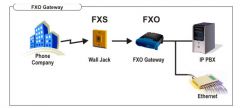
|
|
|
What is an FXS Gateway
|
An FXS gateway is used to connect one or more lines of a traditional PBX to a VOIP phone system or provider. Alternatively, you can use it to connect analog phones to it and re-use your analog phones with a VoIP phone system. You need an FXS gateway because you want to connect the FXO ports (which normally are connected to the telephone company) to the Internet or a VOIP system.
|
|
|
Show an FXS Gateway
|

|
|
|
What is An FXS adapter a.k.a. ATA adapter?
|
An FXS adapter is used to connect an analog phone or fax machine to a VOIP phone system or to a VOIP provider. You need this because you need to connect the FXO port of the phone/fax machine to the adapter.
|
|
|
Show a solution using an FXS Adapter
|
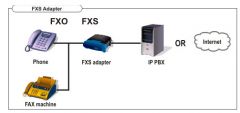
|
|
|
How does FXS /FXO Techically work?
|
Connecting
FXS/ FXO procedures – how it technically works If you are interested to know in more technical detail how an FXS/ FXO port interoperate, here is the exact sequence: When you wish to place a call: 1.You pick up the phone (the FXO device). The FXS port detects that you have gone off hook. 2.You dial the phone number, which is passed as Dual-Tone Multi-Frequency (DTMF) digits to the FXS port. Inbound call: 1.The FXS port receives a call, and then sends a ring voltage to the attached FXO device. 2.The phone rings 3.As soon as you pick up the phone you can answer the call. Ending the call – normally the FXS port relies on either of the connected FXO devices to end the call. Note: The analog phone line passes approximately 50 volts DC power to the FXS port. That’s why you get a faint ‘shock’ when you touch a connected phone line. This allows a call to be made in the event of a power cut. |
|
|
What is H323?
|
H323 is a set of standards from the ITU-T, which defines a set of protocols to provide audio and visual communication over a computer network.
H323 is a relatively old protocol and is currently being superceded by SIP – Session Initiation Protocol. One of the advantages of SIP is that its much less complex and resembles the HTTP / SMTP protocols. Therefore most VOIP equipment available today follows the SIP standard. Older VOIP equipment though would follow H 323. |
|
|
What is RTCP?
|
RTCP stands for Real Time Transport Protocol and is defined in RFC 3550. RTCP works hand in hand with RTP. RTP does the delivery of the actual data, where as RTCP is used to send control packets to participants in a call. The primary function is to provide feedback on the quality of service being provided by RTP.
|
|
|
What is RTP?
|
RTP - short for Real Time Transport Protocol defines a standard packet format for delivering audio and video over the internet. It is defined in RFC 1889. It was developed by the Audio Video Transport Working group and was first published in 1996.
RTP and RTCP are closely linked – RTP delivers the actual data and RTCP is used for feedback on quality of service. |
|
|
What is ECHO cancellation?
|
Echo cancellation is the process of removing echo from a voice communication in order to improve the voice call quality. Echo cancellation is often needed because speech compression techniques and packet processing delays generate echo. There are 2 types of echo: acoustic echo and hybrid echo.
Echo cancellation not only improves quality but it also reduces bandwidth consumption because of its silence suppression technique. |
|
|
What are the five questions that you need ask on VoIP elements?
|
Physical Interfaces
Ethernet (RJ-45), Phone (RJ-11), or T1 IP address (one or multiple) Does it support codec? G.711, G.726, G.729A, G.723.1 Does it support VoIP signaling? H.323, SIP, etc. Does it support legacy signaling? station signaling, ISDN/Q.931, SS7/C7 |
|
|
What is an ATA?
Which of the devices has the intelligence for the NANP? |
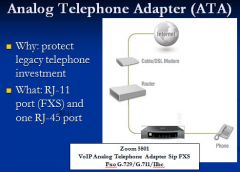
ATA has two ports. One is RJ-11 and the other is RJ-45.
Whenever you see a RJ-11 port you have know whether it is FXO or FXS. The RJ-11 adapter on the ATA connects to the legacy phone (station) so it is FXS. Which is an anlaog port. FXO goes to the central office The ATA has capabilities to support e.164 |
|
|
If there is VoIP there must be these two processes
|
Digitization use codecs and Packetization use RTP and RTCP
|
|
|
If a device supports codec what is mandatory?
|
It is required that it must support G.711 codec
|
|
|
When the delay is longer than X you will need support for Echo Cancellation
|
30ms, Which means nearly every device will need Echo Cancellation
|
|
|
What is the solution to problem of SIP or H.323 ports being NAT'ed by the router?
|
STUN – Simple Traversal of UDP over NAT
The STUN protocol allows applications operating through a network address translator (NAT) to discover the presence of a network address translator and to obtain the mapped (public) IP address (NAT address) and port number that the NAT has allocated for the application's User Datagram Protocol (UDP) connections to remote hosts. The protocol requires assistance from a 3rd-party network server (STUN server) located on the opposing (public) side of the NAT, usually the public Internet. |
|
|
Why do need an FXO port on an ATA device?
|
Three reasons- the FXO port of the ATA connects to an FXS 'device' (the POTS port – your tel line socket on the wall) – so the ATA can receive POTS incoming calls, and divert them to the VoIP 'port' of the ATA, alternatively can receive VoIP calls and divert them to the POTS line via the FXO port.
FXS devices supply approximately 50 volts DC power to the line. During an emergency, FXO devices can use FXS line voltage for power in order to remain operable in the event of a local electrical power failure. |
|
|
How many RJ-45 ports do a IP phone typically have and why?
|
The IP Phone serves as switch in order to support environments where there is only one LAN ports available
|
|
|
If a phone has an RJ-11 port and an RJ-45 port what two processes must be involved?
|
Digitization and Pacetization
|
|
|
What is a big advantage of Voip over Traditional services?
|
Mobility. Ability to take adapter with you and use phone service with any broadband connection.
|
|
|
Is it possible to have one phone with many telephone numbers?
|
Yes its Central Office feature that is usually very expensive/
|
|
|
Is it possible to have an IP phone with many telephone numbers?
|
Yes. It's very easy. Simply need Service Provider to map multiple numbers to a single IP address.
|
|
|
What is SIP trunk?
|
Trunk is betweem two switches, such as between PBX and CO switch. There is no phyiscal connection. It's a virtual trunk to on top of IP. It's a PSTN connection over IP,
It's connection between two gateways, one on the enterprise side and other on the service provider side. |
|
|
Migration from PBX to IP-PBX
Show the legacy, transition, and target architectures |
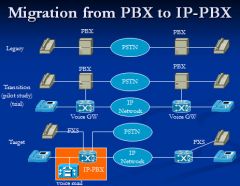
|
|
|
How are FXO lines used in a Small/Medium Office Configuration
What are the primary components of this arcitecture? |
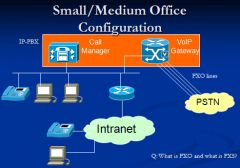
|
|
|
What services are provided by the Call Manager?
|
Call Manager
An industry terminology (not a standard terminology) H.323 GateKeeper SIP Server Linux or Windows Platform Signaling Call Features (PBX-like features) Management Features API Support |
|
|
Does the Call Manager need to support codecs?
|
No. It's for signaling and it's all IP.
|
|
|
What service does the VoIP Gateway provide
|
Gateway to the PSTN
FXO (RJ-11) – analog line Signaling (SIP and/or H.323) Voice codec (G.711, G.729A, etc.) DTMF and Loop start IP/Ethernet (RJ-45) |
|
|
What is the Simplest Approach for Small Medium busines
|
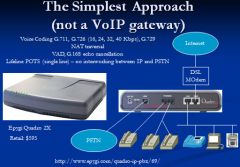
|
|
|
What is T.38?
|
FAX was designed for analog networks, and does not travel well over a VOIP network. The reason for this is that FAX communication uses the signal in a different way to regular voice communication. When VOIP technologies digitize and compress analog voice communication it is optimized for VOICE and not for FAX. Subsequently, there are a number of things you need to take note of when you move to a VoIP Phone System.
If you want to continue using your old fax machine, and you want to connect to your VoIP phone system, its best to use a VoIP Gateway and an ATA that supports T38. T38 is a protocol designed to allow fax to 'travel' over a VoIP network. An example configuration of such a setup can be found here. It is also possible to convert to computer based fax and choose a VoIP phone system that supports fax. 3CX Phone System for Windows includes a full featured fax server that is able to receive faxes and forward them in PDF format to e-mail. Faxes can be sent from anywhere in the network using theMicrosoft Fax client & fax server (which comes free with Windows Server 2003 and 2008) Another way to deal with fax when you switch to voip are to connect the fax machine directly to the existing analog phone line and bypass your VOIP system |
|
|
Show the Enterprise Configuration for VoIP?
What is the signaling protocol for T1? |

|
|
|
Show the Cisco approach
|
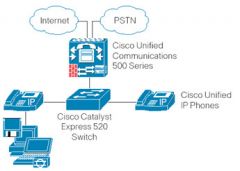
|
|
|
What is the major difference between the small/medium office solution and the enterprise?
|
The PRI interface. There are no FXO lines, since PRI is all digital
|
|
|
IP-PBX must have
|
PSTN interface and features
|
|
|
CAS and ISDN are types of ....
What is physical layer for ISDN |
signaling
T1 |
|

How many IP addresses are needed in this diagram?
What devices need to support G.711 |
Just two for the routers.
The two routers |
|
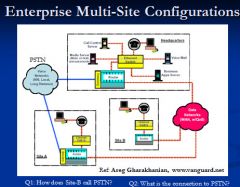
Q1: How does Site-B call PSTN?
Q2: What is the connection to PSTN? |
Through one of the other sites
ISDN or FXO |
|
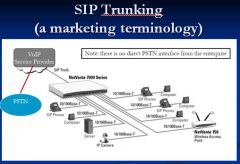
What are the advantages of SIP trunking?
|
No need for PBX. No need for FXO or PRI connections.
Second is scalability You can easily add or remove features the management is easier You must have the PSTN the VoIP service provider and the netowrk. There is no direct PSTN interface from the enterprise. |

